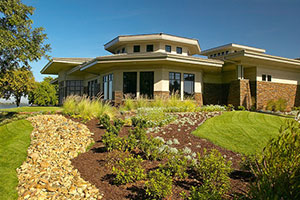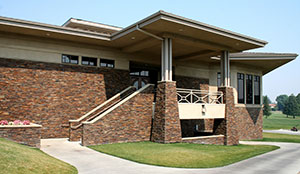Natural Modular Stone Systems: An Important Advancement in Mankind's First Building Material
A Better Process: Quality-controlled Assembly
A natural modular stone system improves upon the traditional process of delivering loose bedrock to the job site directly from the quarry. This new alternative process begins by shipping freshly-quarried natural stone to an assembly factory. At this factory, the loose rock is hand-selected for color consistency and cut into forms that fit within specified dimensions. The rock is then assembled into a variety of structures, like panels for wall veneers, floor mats, and accessories, and delivered to the job site as modular components that are easily fitted together and installed, thus saving costs in both time and labor.
Adding the intermediary assembly process, between the quarry site and the job site, has addressed and eliminated many of the deficiencies that existed in the straight delivery method.Â
Real Stone Panels, Mats, Columns and Accessories
These natural modular stone systems are preassembled and standardized wall panels, wallmats, floor mats, columns and accessories made of real stone. The individual stones are hand-selected and trimmed and then affixed together to form a quality-controlled modular unit. These panels are then fastened together to create a complete veneer surface on a project exterior, interior, wall or floor.
Modular panels are available in many different types of stone, colors, and configurations. For example, panels have been created in a drystacked veneer, a design in which no mortar is present. Wallmats are available in the popular Ashlar pattern of tumbled sandstone. Large modular floor mats are available in materials such as cobblestone and flagstone and commonly referred to as cobblemats and flagmats, respectively.
Additionally, these systems include natural stone accessories in complementing color selections, such as wall caps, column caps, wainscot sills, pool coping, and natural stone tiles to put the finishing touches on a project.
Improved Color Consistency
The color consistency of natural modular stone systems has been dramatically improved over the days of matching loose bedrock on the job site. This improvement in color consistency is achieved by constantly mixing different batches of quarried rock together at the assembly factory. Â This continual shuffling creates a total blended collection of stone that best captures the natural variation of the material.
Every modular unit is created with stones from this thoroughly shuffled inventory of rock. Creating the modular units this way ensures a uniform and consistent look from one unit to the next, while still incorporating a range of natural variation within each product that is unique to natural stone.Â
Improved Production Value and Streamlined Installation
Natural modular stone systems arrive to the job site pre-assembled into panels, floor mats, wallmats, and accessories. The installation process has been extraordinarily streamlined by removing the need for stonemasons to hand-pick individual rocks and then cut them on-site, so that they puzzle together to form the desired structure. Â Now masons simply install quality-controlled modules such as panels and mats that have been designed to fit together.Â
Those natural modular stone systems are installed by first creating a scratch coat substrate that is comprised of a vapor barrier, metal lathe, and a smooth coating of mortar. Then the installer parges the wall by placing a wet layer of mortar on the scratch coat in the area that will be immediately installed and back butters the panel with mortar as well. The panel is then seated flush on the wall, aligned with previously installed panels.Â
The use of natural stone modules, instead of individual natural stones, greatly reduces the total installation time of the project. Also, less cutting reduces the on-site dust, noise pollution, and other associated wastes that require disposal.  Controlling installation costs and production wastes are two ways that natural modular stone systems improve the overall production value of natural stone.
Stockton Golf and Country Club |
||||||
The new clubhouse at the Stockton Golf and Country Club needed to be completed in a very short period of time. The existing buildings on the project had been patterned after prairie style architecture and it was widely accepted that a stone exterior and interior stone fireplaces would be the perfect complement to both the new building and its surroundings. "Natural stone was preferred over artificial stone for both aesthetic superiority and total overall quality, but installing full-bed stone required more time than the project would allow," explained project designer Michael Donaldson AIA, LEED® AP from LDA Partners in Stockton, California. The solution was natural modular stone systems. "These systems enabled us to use natural stone and install it in an incredibly streamlined manner," said Donaldson. The individual panels and accessories are assembled in a factory before being delivered to the job site. When the components arrive, they are ready to be installed. "In projects where full-bed stone is used, stonemasons have to custom cut accessories on-site. The ability to have both 45 degree and 90 degree corner pieces pre-assembled and delivered to the job site, ready to be installed, saves a significant amount of labor and time for the stonemason."
"Natural modular stone systems are so user friendly," said project stonemason John Wait, owner of Wait Masonry in Lodi, California. "Available accessories, such as interlocking corners and finished ends dramatically simplify the installation and they look great." In total, the clubhouse was two stories and 44,000 square feet. Using natural modular stone systems, Wait and his team were able to complete the natural stone installation four weeks early. |
Â
Innate Durability
Natural stone panels are able to offer building owners and homeowners alike the durability that is impossible to match in artificial stone products. The rock used in natural modular stone systems are culled from the sides of mountains and designed by nature to withstand the rain, wind, and sun with minimal weathering. As with the full-bed stone, weathering actually increases the beauty and character of the veneer over time.
Easy to Maintain
Beyond being more durable than artificial stone, these natural stone systems are easier to maintain. If a rock is chipped, the chip simply reveals deeper layers of rock. Natural stone does not need to be touched up or repainted when chips occur.  Natural stone can be power washed, washed in a mild acid or lightly brushed without damage, unlike faux products. If paint is accidentally applied to a natural stone, a solution designed to remove paint can be applied to the surface of the rock without damaging the natural finish or luster of the stone.
Designability
 |
 |
Front and back view of standard panel Photos courtesy Real Stone Source, LLC. |
Â
Every stone in every modular unit has been hand-selected in a quality-controlled, factory environment. This consistency in material, size, shape, and color is important to design teams that need to know that the final stone structure will match their specified design, every time. Beyond consistency throughout one project, design teams need to know that projects in different parts of the world, built at different times, will be built with the same consistency and uniform look with which they were designed.











